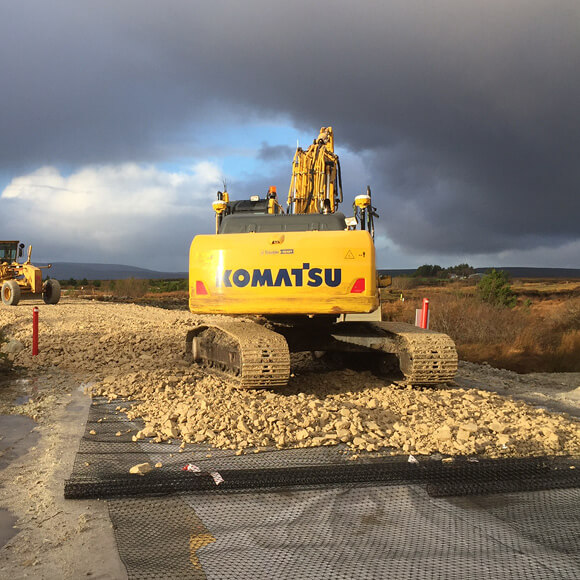Delivering sustainable solutions for the wind energy sector with geosynthetics
by Drew McCartney, on July 01, 2021
Sustainability in the supply chain
Sustainability continues to be high on the agenda in every field across the world and a core focus of Wind Europe’s “Industry Principles for Supply Chain Sustainability” is the environment.
Here, it states that the industry and its suppliers shall “take a precautionary approach to environmental protection and climate change related to activities, products and services” and also “ensure delivered products incorporate environmental aspects throughout the product lifecycle, from design through manufacturing”.
To support the sustainability agenda, geosynthetics can play a very important part in supporting this during the delivery of temporary and permanent works by helping to deliver the project quickly, economically and safely.
Stable access roads, site compounds and working platforms
Unpaved temporary access roads, compounds and working platforms are a critical aspect of enabling works for both onshore and offshore wind energy projects. While supporting extremely heavy loads, these often have to be built on weak or variable ground.
An aggregate layer stabilised with Tensar geogrids performs as a composite, due to the interlocking mechanism and particle confinement that develops between the aggregate and the Tensar stabilisation geogrid. This Tensar mechanically stabilised layer provides more effective support to the entire pavement structure than aggregate alone, improving performance and saving time and money without compromising on safety.
-(1).jpg)
Wind farm access road stabilised with Tensar geogrid, improving performance whilst saving time and money
Supporting sustainability on site by reducing CO2 emissions
Also, wind energy projects often require large volumes of materials that need to be transported considerable distances to and from site. Reducing material use in construction results in fewer vehicle movements, which can deliver significant CO2 emission savings – by up to 50%, when compared with non geogrid stabilised designs.
Reducing CO2 emissions at Oweninny Wind Farm
Take for example, Oweninny Wind Farm, in County Mayo. A major onshore wind farm scheme in Ireland. Oweninny Power (a joint venture of ESB International and Bord na Móna) plans to build 61 turbines, with a capacity of 200MW, enough to meet the needs of 100,000 homes.
.jpg)
Tensar geogrid helped achieve 50% reduction in CO2 emissions at Owenniny Wind Farm
Phase one involved building 25km of 4m wide unpaved access roads and temporary working platforms at 29 wind turbine locations. The wind farm was constructed on challenging ground, so roads and platforms had to be able to support heavy construction traffic over weak and saturated ground but also be economical to build.
Upon review of the original design proposal, Tensar provided a value engineered solution which maximised the performance of the working platforms and access roads mechanically stabilised by Tensar geogrids. The increased efficiency reduced the working platform thickness by 40% to 50% (depending on ground conditions) while still meeting the loading requirements. The volume of aggregate required was reduced by over 50% leading to major reductions in CO2 emissions. Key to achieving this figure was the reduction in aggregate truck movements, which for this project was around 550 vehicles. By removing substantial volume of traffic from rural roads, not only did we contribute towards an environmental solution but were able to promote the health and safety benefits as well.
Check out some success stories on renewable projects here.




.jpg?width=400&height=400&ext=.jpg)